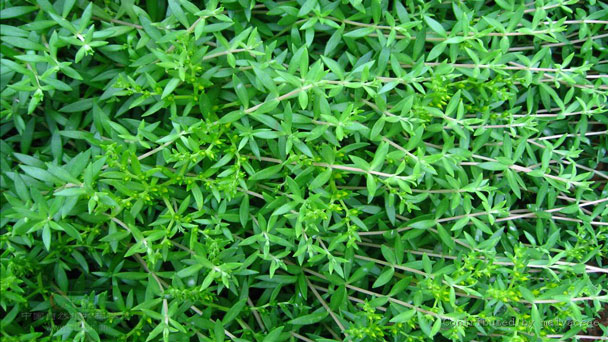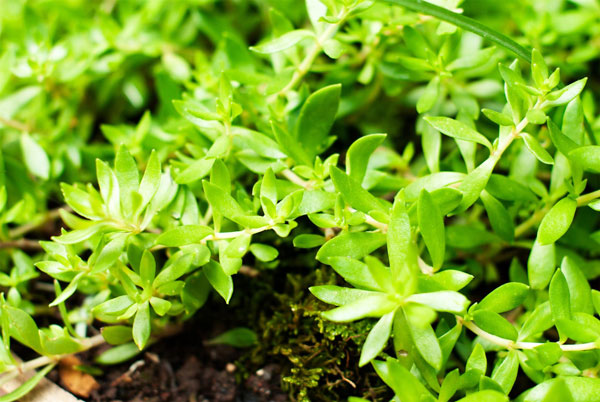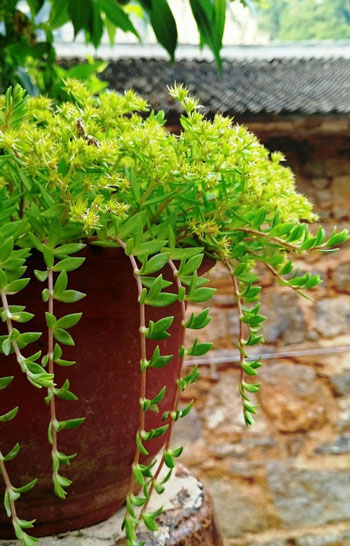Stringy Stonecrop: Grow & Care for Sedum Sarmentosum
Written by Iris
Oct 09 2021

Stringy Stonecrop (Sedum Sarmentosum) generally grows in rocky crevices on hillsides, ravines, riversides and moist places. It is easy to care for and does not have strict environmental requirements. It can be planted in front of and behind the house, and can also be planted in pots. The branches hang on the edge of the pot and are very beautiful.
Once the seedlings have started to sprout and have had some time to grow, they can be planted in well-draining soil in full sun. Keep an eye on them until they’ve started to noticeably grow and spread, as that’s the point where you’ll know for sure that you can cut back on their watering.
Stringy Stonecrop (Sedum Sarmentosum) can also be infected by powdery mildew disease. Spacing plants further apart and not crowding them with other perennials will help keep the leaves dry and lessen the effect of mildew. Thin out the crowns of crowded clumping Stringy Stonecrop (Sedum Sarmentosum) to increase air flow.
In addition to that, since it's a succulent if any of the leaf segments of the plant fall off, they can root and grow into an entirely new plant. This can happen over and over again until you have a thick, large “carpet” comprised completely of gold moss. So while a singular plant may grow to cover a span of several feet, it will definitely establish itself and spread to cover more and more ground the longer you leave it.
How to Propagate Stringy Stonecrop (Sedum Sarmentosum)Stringy Stonecrop Propagation with SeedsStringy Stonecrop Propagation with Tip CuttingsStringy Stonecrop Propagation with Stem CuttingsHow to Care for Stringy Stonecrop (Sedum Sarmentosum)Stringy Stonecrop LightingStringy Stonecrop Soil CareStringy Stonecrop WateringStringy Stonecrop Temperature & Humidity CareStringy Stonecrop Fertilizer CareStringy Stonecrop Pruning CareStringy Stonecrop Pests & Diseases CareStringy Stonecrop (Sedum Sarmentosum) ProblemsIs Stringy Stonecrop Invasive?How Big Does Stringy Stonecrop Get?
How to Propagate Stringy Stonecrop (Sedum Sarmentosum)
Stringy stonecrop can be propagated by seed or asexually, i.e., by cuttings, splitting, or laying, and is highly viable. It is usually propagated by branching or cuttings. Planting should be carried out in early spring, cuttings can be at any time.Stringy Stonecrop Propagation with Seeds
Given the ease and speed of propagating stringy stonecrop (Sedum Sarmentosum) from tip cuttings and stem cuttings, waiting for the seeds to germinate makes seed propagation a labor of love. Another drawback to seed propagation is that some hybrid varieties do not grow true to seed. A tip or stem cutting is an identical clone of the parent plant, but the seed contains the genetic material of two plants, leading to unpredictable outcomes. To propagate Stringy Stonecrop (Sedum Sarmentosum) from seed, place the seeds in damp sand and gently press them down. Keep the seeds between 85 and 95 degrees Fahrenheit, and cover the seeds with something clear, like a plastic wrap, to help keep the soil damp, and to keep the humidity and warmth in.Once the seedlings have started to sprout and have had some time to grow, they can be planted in well-draining soil in full sun. Keep an eye on them until they’ve started to noticeably grow and spread, as that’s the point where you’ll know for sure that you can cut back on their watering.
Stringy Stonecrop Propagation with Tip Cuttings
One of the simplest ways to propagate Stringy Stonecrop is to take a cutting from the tip of a plant and simply stick it in the soil. Take a 6-inch tip cutting from a healthy sedum and remove the lower leaves. Fill a nursery tray with damp sand and stick the bottom half of the sedum tips in the soil. After about two to three weeks, a gentle tug will tell you if the cutting was successful. If it feels snug in the soil, the tip cutting is already putting out roots.Stringy Stonecrop Propagation with Stem Cuttings
Propagate Stringy Stonecrop by stem cutting is another quick way to create new plants. Dig around the base of an existing plant and sever a few new stems from each plant. You can replant the stem cuttings directly into the garden or into a seed tray containing damp sand. Take stem cuttings in spring when the plants are putting out new growth.
How to Care for Stringy Stonecrop (Sedum Sarmentosum)
Stringy Stonecrop Lighting
Most Stringy Stonecrop (Sedum Sarmentosum) like full or part sun (5 or more hours of direct sun per day). A few stonecrop species such as Sedum ternatum are woodland plants that like to grow on top of rocks in dappled shade. And some of the highly variegated Stringy Stonecrop (like S. alboroseum 'Lemonade') with pale green, yellow and white foliage need dappled sunlight to prevent sunburn.Stringy Stonecrop Soil Care
No matter what type of stonecrop plant you buy you should plant it in well drained soil. Heavy wet soil is sure to rot both tall and creeping Stringy Stonecrop (Sedum Sarmentosum) alike. Their fondness for well-drained soil makes sedum plants great for raised beds, hillside slopes, sandy soil, rock gardens, crevice gardens, containers, and green roofs.Stringy Stonecrop Watering
Sedum plant needs more water in the spring and summer, but you can allow the topsoil to become slightly dry between each watering. During the winter season, reduce watering.Stringy Stonecrop Temperature & Humidity Care
Growing zones vary by sedum species. But in general, these plants can tolerate a wide range of temperatures, though very high temperatures (above 90 degrees Fahrenheit) can lead to scorched leaves. Sedum plants also usually tolerate humidity well. However, sharp soil drainage is especially important in areas with high humidity to prevent the plants from sitting in too much moisture.Stringy Stonecrop Fertilizer Care
Stringy Stonecrop (Sedum Sarmentosum) tolerate low-fertility soils. A soil too rich in nitrogen can cause clumping plants to flop and flower later. Adding a 1 inch thick layer of compost when planting and annually in spring should be enough to keep your Stringy Stonecrop (Sedum Sarmentosum) growing and flowering strong.Stringy Stonecrop Pruning Care
Sedum flowers are attractive from bud stage to when the flowers dry on the plant. Gardeners have a choice to deadhead (trim) clumping Stringy Stonecrop (Sedum Sarmentosum) after they bloom, or leave the drying flowers on the plant for some fall color. Some gardeners even harvest the dried flowers for indoors arrangements.Stringy Stonecrop Pests & Diseases Care
Stringy Stonecrop (Sedum Sarmentosum) are relatively trouble-free plants in the landscape. The key is keeping the soil well drained and not too fertile. On wet, rich soils, the crown and stems can quickly rot due to diseases such as anthracnose and blight. Once infected, there's little you can do other than cultivate the soil to help it dry out.Stringy Stonecrop (Sedum Sarmentosum) can also be infected by powdery mildew disease. Spacing plants further apart and not crowding them with other perennials will help keep the leaves dry and lessen the effect of mildew. Thin out the crowns of crowded clumping Stringy Stonecrop (Sedum Sarmentosum) to increase air flow.

Stringy Stonecrop (Sedum Sarmentosum) Problems
Is Stringy Stonecrop Invasive?
There's a reason why this plant is also known as spreading stringy stonecrop. Some people appreciate stringy sedum groundcover for its chartreuse foliage and yellow blooms, as well as its ability to grow and keep weeds in check, even in difficult spots like rocky slopes or hot, dry, thin soil. Stingy stonecrop also performs well between stepping stones and pavers, and can tolerate a certain amount of foot traffic. However, keep in mind that stringy stonecrop is a bee magnet, so it may not be a good plant for childrens' play areas. Think twice before growing stringy sedum groundcover if you prefer a tidy, well-behaved garden. Stringy stonecrop in gardens can be extremely invasive and can easily out-compete timid plants, including some of your favorite perennials. It has become a serious problem in some areas of the eastern and southern United States.How Big Does Stringy Stonecrop Get?
As far as height goes, it doesn't get much taller than three to five inches, which makes it a fantastic ground cover that you’ll never have to mow. However, if we're talking about how far will it spread, that's an entirely different matter. Not only does gold moss have a fairly rapid growth rate, but it roots as it grows, so individual segments of the main plant can establish themselves, and may not die if you just cut them.In addition to that, since it's a succulent if any of the leaf segments of the plant fall off, they can root and grow into an entirely new plant. This can happen over and over again until you have a thick, large “carpet” comprised completely of gold moss. So while a singular plant may grow to cover a span of several feet, it will definitely establish itself and spread to cover more and more ground the longer you leave it.

Latest Updated
- Benefits of Bugleweed - 7 Science-backed Health Benefits
- Bugleweed Dangers & Side Effects - Is It Poisonous?
- How to Plant Evergreen Trees - What You Should Know
- When to Plant Evergreens - Grow Guide for Evergreen Trees
- 12 Wonderful Evergreen Shrubs for Your Garden
- 12 Popular Evergreen Plants with Pictures for Beginners
- When And How To Prune A Lilac Bush Like a Pro
- How to Grow & Care for Lilac Vine (Hardenbergia Violacea)
- Japanese Lilac Tree (Syringa Reticulata) Care & Propagation Guide
- Shumard Oak Pros and Cons - What to Know
Popular Articles
- Winter maintenance of Antirrhinum Majus
- How to Grow Terminalia Mantaly Tree
- How to Grow and Care for Crossostephium Chinense
- How to grow Antirrhinum Majus in spring
- Peristeria Elata (Dove Orchid) Profile: Info & Care Guide
- Underwatered Snake Plant (Sansevieria Trifasciata) - Signs And How To Fix
- How to Care for Brazilian Jasmine Plant (Mandevilla Sanderi)
- How to Grow & Care for Graptopetalum Purple Delight in Summer
- Rosa Chinensis (China Rose): Plant Growing & Care Tips
- How to Care for Baby Sun Rose (Aptenia Cordifolia)